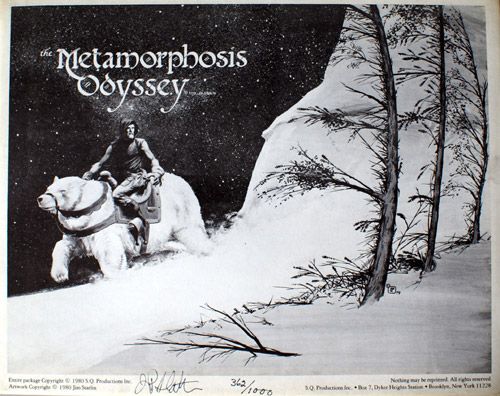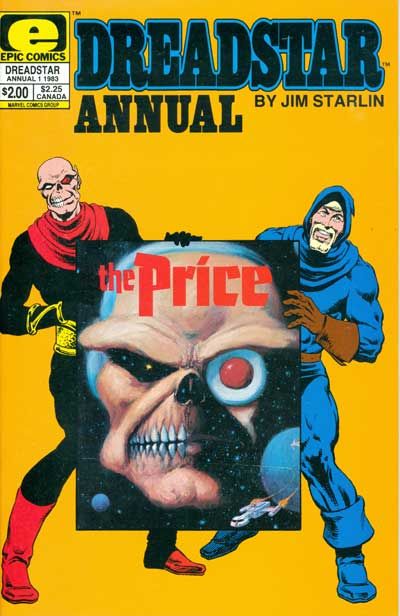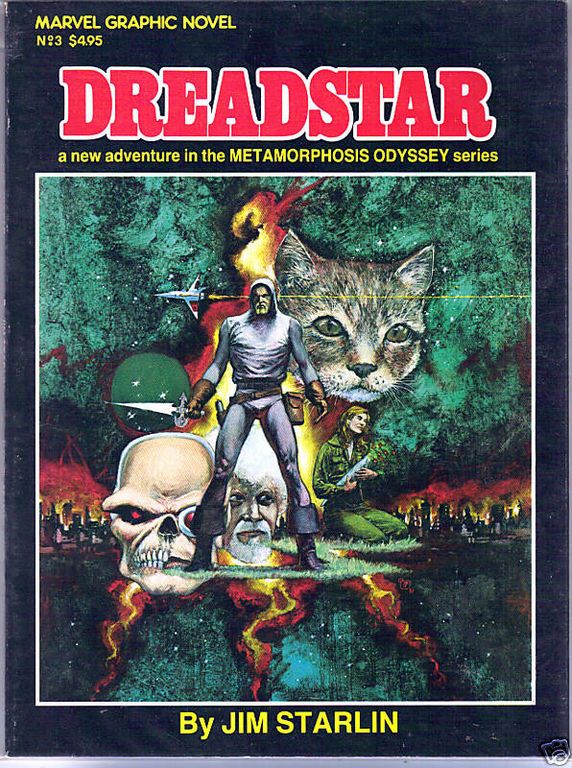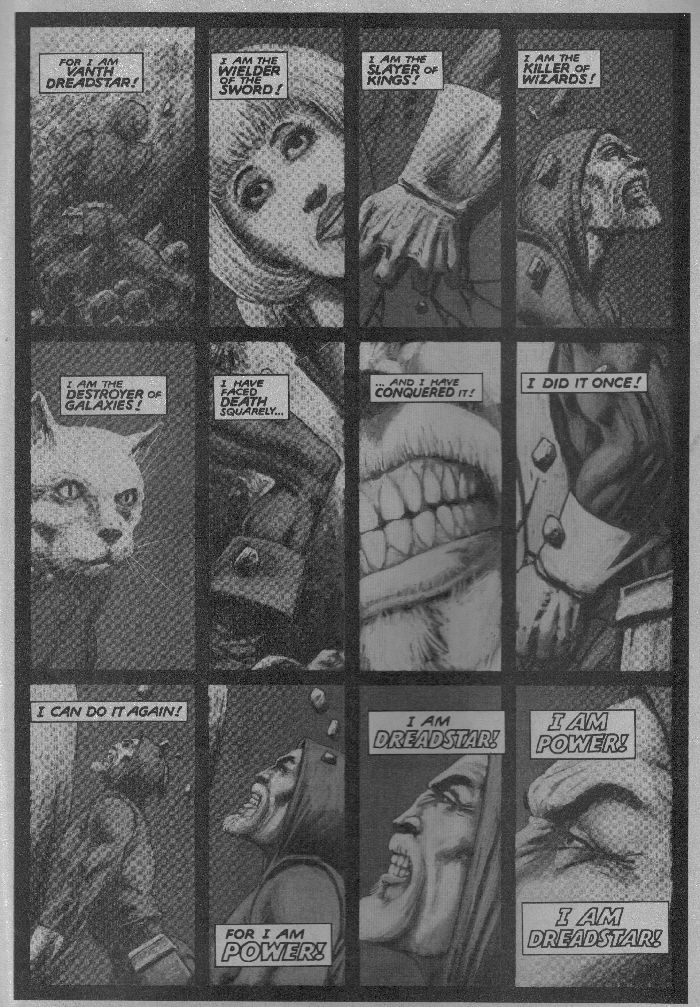Dreadstar December officially begins tomorrow, but, before that, I wanted to do a brief post discussing the three major works (and one short story) that came before the ongoing Dreadstar comic series. Let me introduce you to a man by the name of Vanth Dreadstar, who, I have on very good authority is POWER!
The Metamorphosis Odyssey was originally serialised in Epic Illustrated #1-9, acting the magazine's initial centrepiece/ongoing narrative. It wasn't Jim Starlin's first creator-owned work, having done some stories featuring Darklon the Mystic for Eerie previously as well as some stuff in Star Reach, I believe, but it was his first attempt at something big and bold. He took a drastically different approach with this story, doing painted art, first in black and white and, then, in colour. That painted approach is what unifies these three works and separates them from Dreadstar the ongoing series. As well, if you're familiar with Dreadstar, The Metamorphosis Odyssey stands out for having a more 'adult' approach with not being afraid to show some nudity and by featuring only one character that would later show up: Vanth Dreadstar. And, honestly, he's not the lead/protagonist you'd imagine.
The plot of the story is fairly simple: Aknaton, an immortal mystic/'god' from the race Osirosian, collects a group to end an ongoing conflict with the conquering, unstoppable Zygoteans. The Zygoteans wiped out Aknaton's race basically and they were, as far as we'd be concerned, gods. Immortal, highly advanced, and unable to stop the Zygoteans, only slow them. Aknaton has come to the conclusion that the entire Milky Way galaxy will fall to the Zygoteans and puts into action his 'final solution.' Centuries before, he planted the seeds for this plan on various worlds. There's Za, the first of his cannibal race to achieve intelligence, Juliet, a 15-year-old girl from Kansas (Aknaton seems to be the inspiration for the Egyptian pantheon), and Whis'Par, the culmination of the artificial life Aknaton had created on the forest world. He also retreives Vanth Dreadstar, a warrior leading his world against the Zygoteans thanks to a mystical sword that Aknaton left on his world. It's bonded to them, appearing when he needs it, giving him advanced strength, and healing abilities. Aknaton's plan is to destroy the Milky Way galaxy using the Infinity Horn, a weapon of such destructive capabilities and requiring Za, Juliet, and Whis'Par to use it and also have them transcend to become a new kind of being (never seen). Vanth and Aknaton survive, traveling in stasis to another galaxy, eventually landing millions of years later. In a rage over what happened, Vanth kills Aknaton who welcomes death after what he did, though still saying that it was necessary.
If you've read Dreadstar, you'll know this plot since it was recounted many times. Starlin said in an interview in Epic Illustrated #9 that The Metamorphosis Odyssey was a way for him to tell a story about the Vietnam War. Vanth represents the warrior that follows orders only to find out how monstrous those orders are; Whis'Par is the believer who knows the big picture and still goes along with it; Juliet questions everything from the beginning; and Za doesn't question and doesn't seem to care about the big picture, willing to go along with what Aknaton (the government/authority/god) says. Since reading that, I've debated how effective this interpretation of the story is. I can see where Starlin is coming from, but it doesn't really work for me. I guess Aknaton simply destroying the Milky Way galaxy is the same as surrender/retreat. He can't beat the Zygoteans, so he napalms everything, deciding that it's better to die than to be slaves to conquerers. It's not an easy position to defend -- but it's also difficult to say he's entirely wrong. If his race, the most powerful and advanced, couldn't stop the Zygoteans, what chance did any other have?
The events here influence Vanth Dreadstar and also give readers a head's up about Starlin's storytelling (if you didn't already know from his runs on Captain Marvel and Warlock): he isn't afraid to make big, sweeping changes. Only one character from this story survives (though, I guess, Za, Whis'Par, and Juliet survive... kind of) and, at the end, he wants nothing to do with violence or war, overcome by guilt for his participation in the deaths of billions (trillions?). Out of the three 'preludes,' it's the only one that stands on its own completely. When it ends, you could never read another story starring Vanth Dreadstar and be just fine.
Starlin's art is in a process of transformation here as he learns what he can and can't do with paints. I don't know how many problems stem from the printing/paper/age of the paper, but, sometimes, his colour work is muddled and not very good. The story begins in black and white and looks very strong that way. There's a nice, soft texture to his line work in the black and white art. I particularly love the chapter about Za, introducing him as the only intelligent, truly sentient creature from a race of primitives. It's Starlin doing the opening of 2001: A Space Odyssey and the art is gorgeous. Expansive landscapes, lots of mist and fog... The introduction of colours paints is hit or miss. Part of the use of paints is Starlin basing some characters on models. Vanth Dreadstar appears to be Starlin himself, while he used friends for other characters. One notable model is Frank Miller as Juliet's father (and it's pretty obvious if you know what Miller looks like).
The Metamorphosis Odyssey is also the title of all of these stories. This is really book one with The Price acting as book two, the graphic novel Dreadstar as book three, and the Dreadstar ongoing series as book four. It's an unfinished story. One thing that I wish Starlin would return to do is finish Vanth Dreadstar's life as he suggested he would in that interview in Epic Illustrated #9: "At the end of the series, when I finally decide to kill Vanth Dreadstar off, [Za, Whis'Par, and Juliet will] be brought back in. I've got the end all plotted out."
The Price was originally published as a black and white graphic novel for Eclipse and, later, was coloured using a process to shift from black and white paints to colours, reprinted in Dreadstar annual #1. It's an odd book, because it barely has Vanth Dreadstar in it at all. Instead, it introduces us to the new galaxy that Dreadstar and Aknaton arrived in at the end of The Metamorphosis Odyssey, the Emperical Galaxy, with a particular focus on Syzygy Darklock. In this galaxy, a war between two empires has been going on for centuries. On one side is the Monarchy, a 12-century old dynasty, and, on the other, is the Instrumentality, a theocracy. Neither side wants the war to end having based their entire societies and economies around it, sacrificing lives but never truly advancing or gaining on the enemy. Syzygy Darklock is a bishop in the Instrumentality's church and a powerful, highly skilled one at that. He's something of an up-and-comer, a threat to the Lord Papal, the ruler of the church. At the beginning of The Price, Syzygy's brother is killed and the story is about him gaining revenge and the cost of doing so.
The idea that power comes with a high cost is one that Starlin returns to again and again. He also ties it in with an idea he uses less, but still crops up from time to time: no matter how smart and powerful you are, you're just a pawn of fate or someone smarter and more powerful. The murder of Syzygy's brother is a ruse to put the bishop on a path to gain the necessary power and knowledge to be worthy of his fate. A powerful wizard sets it all in motion, willingly sacrificing his life to Syzygy's anger, knowing that he served the universe in a larger way. Syzygy, on the other hand, sacrifices his body for power. When he obtains a large amount, he loses an arm, a leg, an eye, and is badly burned (hence his grotesque appearance on the cover). More than that, when more power is necessary, he sacrifices his loyal friend, a nun in the church, to an eternity of damnation and torment. Unlike Vanth Dreadstar, he willingly does monstrous deeds -- first, for revenge, and, then, because he's seen his fate and embraces it even with guilt. It isn't until the final pages that Dreadstar appears as Syzygy finds him, beginning to prepare him for his fate.
Starlin's art in The Price builds on his work in The Metamorphosis Odyssey, though I've only seen the colour version. It's hard to separate his line work from the painted colours since they're so overpowering. Knowing that he didn't do the colours makes it more difficult to discuss his art. Here, though, he does do something that would show up in the next book: he draws a giant cat-god, using a very realistic approach to the character's head. I don't know why, but Starlin seemed to have a real fascination/interest in cats. It's actually a little strange to read this if you're just familiar with Syzygy from the ongoing. Seeing him as a regular human, not the weird mystic... strange.
Starlin's storytelling in this is a little overbearing. Lots of captions, lots of dialogue. There's a big infodump to the begin the story as he explains the entire history of the Monarchy/Instrumentality conflict. His dialogue can be a little too on the nose at times with characters expressing themselves in obvious, blunt ways. It's something that seems clunky now and becomes problematic at various times, but I don't mind as much here. These stories are meant to be very obvious and direct.
The Dreadstar graphic novel was the third graphic novel published by Marvel and done in exchange for Starlin doing The Death of Captain Marvel. It picks up where The Metamorphosis Odyssey left off with Vanth Dreadstar on an alien planet, pissed off, and half insane. He abandons his sword and succumbs to his injuries, found by the residents of the planet, a race of cat-people. The cat-people were bred by the Instrumentality to be warriors, but turned out to be peaceful and good farmers, so they were left to farm and provide food for soldiers. In their village, a human woman who was a scientist along with her dead husband takes in Vanth and nurses him back to health. Eventually, they fall in love and spend decades together (though Vanth doesn't age as a result of his mystic sword (which returns to him of its own accord one night). When Syzygy lands on the planet, he and Vanth begin meeting once or twice a month to talk and learn, developing a mentor/protege relationship. Syzygy slowly teaches Vanth everything he'll need to know to meet his destiny of ending the war. Except Vanth wants no part of that, happy to leave his violent life behind him. Until a Monarchy raiding party destroys the village, kills his wife, and leaves him hungry for revenge. He takes it by joining the Monarchy military, rising through the ranks until he's in a position to kill the king and threaten his successor with the same treatment if he doesn't work to end the war as Dreadstar and Syzygy have laid out. In the end, the two prepare to continue the task at hand.
It's hard to ignore the influence of Star Wars on this story. The Vanth/Syzygy stuff is very similar to the Luke/Obi-Wan stuff in the film, right down to the excuse Luke has for leaving with Obi-Wan to fight the Empire. Starlin uses many of the same visuals with similar looking houses and a land-speeder. I don't mind, it just jumped out at me quite a bit.
The storytelling is brisk here as Starlin prefers to tell rather than show. Decades pass in a page before years pass quickly as well. We never get a strong sense of how peaceful/great Vanth's life is as a farmer. It's told to us, but Starlin knows that it isn't the appeal of the story. Watching Vanth return to his former ways is teased with a violent outburst at Syzygy as he tries to convince Vanth to leave. It really hits home when he goes after the king of the Monarchy, donning his old outfit of a blue hooded shirt. He hadn't worn that since collapsing at the beginning of the story and it becomes his initial 'costume.' He also draws Vanth as slightly pudgier before he returns to his old self. He wouldn't really gain weight because of his strange nature, but it visually shows him as 'soft' and 'weak'... and 'content.'
Starlin sends home the message that the war must end during Vanth's time in the military. One of the reasons he's promoted is to take him out of active service because he's been winning too many battles. It's upsetting the stalemate condition that Monarchy lives in with the Instrumentality, but is saving lives. Vanth is concerned with ending the war to save lives, wanting to end the corruption that only helps those in power.
The graphic novel effectively builds off the previous two to have the two 'leads' cross paths and join forces, setting up the ongoing series.
A Dreadstar short story was published in Epic Illustrated #15, originally meant for another magazine at Marvel, but used here to act as a prologue for the ongoing series, which was to be Epic's first creator-owned ongoing comic. The short has Vanth and Oedi (the sole survivor of the cat-people) at an Instrumentality mining colony to steal a ship. In the process, they get found out and a woman is trapped after some of the rocks collapse. Vanth shows off his compassion by using his power to save her, proving that he's better than the Instrumentality (her own people) when they do nothing. It features one of my favourite pages, which I've scanned in.
It's a decent little short that introduces Oedi as part of the team and shows Vanth and company in action against the Instrumentality. It also introduces Willow, who will become a member of the team. She's the woman Vanth saves though we don't know yet that she'll join the group.
This short is the last time we see Starlin use this softer pencil art style. With the ongoing, he returns to his more traditional pencils and inks. I do like his shading here. It's a nice transitional piece from his painted work to more 'standard' comic art.
Tomorrow, we begin Dreadstar December proper with the debut issue of the ongoing and the proper introduction to Dreadstar and Company.




